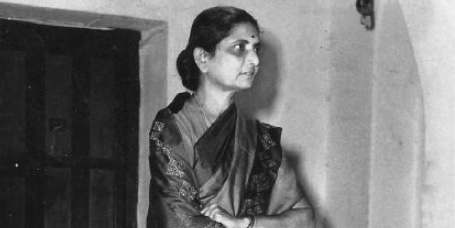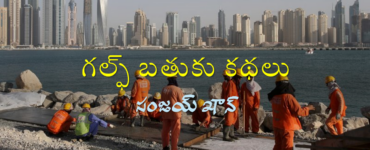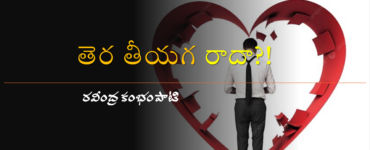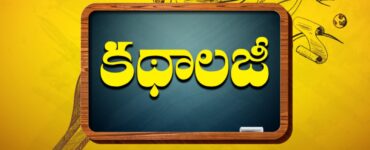This is a reproduction of the Introduction to Sharp Knife of Memory by Kondapalli Koteswaramma, Translated by V. B. Soumya.
When the Hyderabad Book Trust published Kondapalli Koteswaramma’s autobiography Nirjana Vaaradhi in September 2012, we were unprepared for the overwhelming response. Admittedly, we had expected interest because Koteswaramma is the widow of Kondapalli Sitaramayya, the man who founded the People’s War Group, the single most effective threat to the Indian Government and most widespread in the nature of its influence on society. But the response had little to do with this, the book having sidelined Sitaramayya as it were. There was a reissue in a week and a second edition within two months. Readers overwhelmed us with their reaction, both on telephone and subsequently through letters.
We have published some 400-odd books over the last thirty-three years, several of them written by women, several others about women and many among them explicitly feminist, but the response to these from men has mostly been lukewarm, almost as if such books have nothing to do with them and belong to a constituency entirely separate from their world. Nirjana Vaaradhi proved this wrong. There was a flood of calls from men who said that they had wept several times while reading the book. They wanted to know if they could meet Koteswaramma or speak to her over the telephone. A leading journalist made a twelve-hour train journey to Visakhapatnam to meet her. An engineer working in the Tungabhadra project in Karnataka decided that tears were not enough; he would translate the book into Kannada. Three men from different areas purchased a hundred copies each, one distributed them to the public libraries in his district, the others to their friends and acquaintances. One of them wrote to me:
I shed a few tears reading some of the incidents in the book. Imagine being a child widow, married to a rebel with a cause, a freedom fighter, a wife deserted by the man she married who ditches her for another woman, and a mother who lost both her adult children. This lady’s life personifies a fusion of idealism, sacrifice, perseverance, resilience, patience, endurance, struggle, tragedy, suffering, selfless giving, forgiveness, hope and inspiration. Nothing could break her, she was down many times but picked herself up and moved forward. Like someone said, ‘Tough times do not last, tough people do.’
A woman is often defined in terms of her husband. Koteswaramma has always been known as Kondapalli Sitaramayya’s wife even after he left her. By writing her memoirs, Koteswaramma defines herself, her life, her emotions, on her own terms. A story of incredible grace, dignity and resilience, she is revealed not as a tragic figure, not as the wife who was abandoned for the lover, not as the mother who was rejected by her children for the father; she reveals herself as a powerful woman, a survivor with a strong core.
Koteswaramma was born in a rich peasant Reddy family in a village in the fertile Krishna delta of Andhra Pradesh in 1920. She was married when she was barely four or five to her maternal uncle, who died within a few years. Thus, she was left a child widow; yet, she did not know she was one, nurtured as she was in a caring family.
She went to school and grew up in the heady days of the freedom movement. Her mother spun the charkha (spinning wheel), while some among her relatives discontinued their studies to jump full-time into the movement. Koteswaramma herself encountered Gandhi when she was barely ten, and along with other women, took off her gold ornaments and gave them to him.
She grew up in a time of extraordinary importance. The emerging nationalist movement was facing challenges, both in ideology and strategy from different movements—the communist, the socialist movement, and even a fledgling Dalit movement. The present-day states of Andhra Pradesh (AP) and Telengana did not exist at that time. The coastal districts and the southern Rayalaseema ones ceded by the nizam of Hyderabad to the British were part of Madras Presidency and governed from the city of Madras.
Since the construction of the Cotton barrage in 1852 and a host of anicuts across the delta, this area became prosperous. Telangana, the eastern part, was part of the nizam’s state. The two regions—Andhra, then called the Circar districts, and Telangana—had very different trajectories. In the Andhra region, Western education had spread through the medium of English in schools and colleges set up by the British government and more prominently by Christian missionaries. There was a healthy growth in journalistic activity, and the first Telugu journal, Satyadoota, appearing in 1833, followed by several others. Several literary associations too were active, particularly in centres like Masulipatnam, Rajahmundry, Kakinada and Vijayawada, and they had numerous publications and activities.
In this context, a social reform movement swept the ‘upper castes’ of the area. Veeresalingam made efforts for the remarriage of child widows and for the education of girls, while Gurajada Apparao supported him ably with his pioneering writings. The social reform movement in the Circars gradually meshed into the freedom movement.
Alongside a strong nationalist movement that produced leaders like Pattabhi Sitaramayya, Tanguturi Prakasam and Sarojini Naidu, between 1930 and 1932, radical elements in the Congress had begun searching for alternatives. At about this time, the seeds of communism were being sowed in the coastal Andhra region.
The communist movement and party formed the backdrop of much of Koteswaramma’s life. Students from AP who left the state to study began participating in the freedom struggle, mingling with radical elements in the Congress and studying socialist literature.
By 1931, Chandra Rajeswara Rao, Nanduri Prasad Rao, Tummala Venkatramaiah and others had gone to Benares University and begun working in the Young Communist League. By 1934, Amir Hyder Khan and others had started branches of the Communist Party in Madras. Some others like Sundarayya were already members of the Communist Party by 1932.
In Andhra, the party was said to have been founded in September 1934 when the Andhra Provincial Organising Committee was formed at a meeting of communist representatives from different districts at Vijayawada. Almost immediately, it was banned and remained underground from 1934 onwards. In 1942, when the communists supported the war effort after Soviet Russia was attacked by the Nazis, and the British government lifted the ban.
Koteswaramma’s family and the communists arranged her second marriage in 1939 to Kondapalli Sitaramayya, already a party worker at that time. The wedding sealed her lifelong bond with the communist movement. With her husband strongly approving, she began work as an activist. Along with Mahila Sangham activists, she took part in rallies, reproduced and sold party literature from village to village, and was an active member of the cultural troupe, besides caring for her two young children.
Sitaramayya became secretary of the Krishna district unit of the Communist Party, an important post, considering that this district was the heartland of communist politics in AP. When repression on the party became severe, she went underground with several others for five years, from 1946 to 1951, the period coinciding with the peaking of the Telangana peasant movement. By this time, she had two young children.
Hyderabad state was going through a sea change in the late 1940s. It was getting rapidly communalized into Hindu and Muslim forces, and there was a crisis in governance. All of India was involved in the nationalist movement and Hyderabad aimed to be independent. This gave space to the communists who organised the poor and middle peasantry suffering from rank feudalism.
The Telangana movement (1948–51) was an armed revolt of peasants under the leadership of the communists against oppressive landlordism patronised by the nizam of Hyderabad. The revolt started in 1946 in Nalgonda district and quickly spread to all of Telangana in around 4,000 villages. Peasant farmers and labourers revolted against local feudal landlords (jagirdars and deshmukhs) ruling the villages.
The communist-led agitation was successful in liberating over 3,000 villages from feudal lords and 10,000 acres of agriculture land was distributed to landless peasants. Around 4,000 peasants lost their lives in the struggle, fighting private feudal armies. Hyderabad state formally joined the Indian Union in 1948 after a takeover by the Indian army.
While many men among the Communist Party moved between the two regions, those from the coastal region working in the squads in the Telangana area and women in the party were constrained and retained in their own regions. In 1951, the armed struggle was called off, and party cadres returned to an uneasy future. Fissures in the party had been growing after the calling off of the Telangana peasant movement in 1951. The party decided to downscale in a big way and sent its full-timers out to earn their living in different fields.
Those who have worked in radical movements but have been forced into inactivity due to various reasons face great unhappiness—a fact often not acknowledged. Nervous breakdowns and depression are very common. Those who leave are unable to return to their past lives and, very often, their families do not want them either. They are unable to become steady wage-earners due to lack of qualifications and experience, being too old for the job market and having a radical reputation behind them. Their personal relations remain in the shadow of the party or the movement where their friends were. When they leave all this behind, there are few people to share their grief with. Their values of fighting for change, organising people, practising compassion and selflessness become out of place, and they find it difficult to accept the outside world’s values of consumerism, commercialism and so on. What they need is time. Time heals and it gives them the ability to make the change, to attune themselves to fighting for change in the small world around them, to help others in their little areas, and to make the necessary compromises with the revisionist world around them. That this is an incredibly painful process is what has not been written about, and this is what we read in the silences of Koteswaramma’s text.
Women revolutionaries particularly face serious issues when movements subside. The difference in their lives while in the movement and when out is far more marked. Women also invest more in terms of change in lifestyle and aspirations when they join a movement. This investment is not easy to discard later. While, in the long run, it may serve them better, the journey is fraught with sorrow and tension.
Kondapalli Koteswaramma worked in the communist movement in Andhra Pradesh in the 1940s and was underground for five years, away from her native district, her family and her children. When she returned to Andhra Pradesh and to a life among family and friends, she faced not just the normal trials and tribulations of a former activist, but also the prospect of her husband abandoning her and her children being taken away, besides a financial crisis. In short, her world collapsed around her.
Kondapalli Sitaramayya’s liaison with another woman (referred to as ‘that woman’ in Koteswaramma’s text) led to his leaving his wife. The husband who had once gone on a hunger strike so that Koteswaramma would agree to act on stage in the communist troupe was now to turn against her. Sexual liaisons and extramarital affairs conducted by communist leaders and activists were not uncommon—an unhappy reflection of what happens in society at large. What was uncommon was Koteswaramma’s refusal to turn a blind eye to it. She steps very delicately here; she refuses to demonise Sitaramayya or comment on his callous attitude. Yet, her recital of facts and the silences between them tells the reader what could have happened. She recounts Sitaramayya saying, ‘You were once a widow. Yet, I married you and gave you some recognition in society.’ Her response to this in the book is only this, ‘Those words hit me hard.’ Others too castigated her. ‘Some people called me a useless woman, citing the examples of women who put up with everything and stayed with their husbands for the sake of their children. It seems to me that people in distress are a source of amusement for the carefree.’ The bitterness that could mark someone who has been so ill-treated by both husband and society is absent in this voice.
In 1957, Sitaramayya, who had been suspended from the party, ostensibly due to his extramarital liaison, but possibly due to intra-party politics, shifted to Warangal in the heartland of Telangana. He withdrew from political life for a while. Koteswaramma began, in 1960, the painful process of rebuilding her life, studying for about five years, ironically in the hostel for destitute women that Durgabai Deshmukh had set up in Hyderabad.
Downscaling activist numbers told on the Communist Party. The Indo-China war in 1962 furthered deepened the fissure within the party, and in 1964, it split—there were now two parties, the Communist Party of India (CPI) and the CPI (Marxist) (CPM). In the 1967 elections, the two parties together won only twenty seats and lost their position as main opposition to the Swatantra Party. They were virtually decimated in Andhra Pradesh. Its mainstay, the Kammas, deserted it on a large scale, and its foot soldiers, the Scheduled Castes, also switched over, almost entirely to the Congress.
The fire of Naxalbari in 1967 and the Srikakulam peasant revolt in 1969 were unable to restore the communists to their position. It further weakened the electoral left. Charu Mazumdar led many from the CPM to form a new group. In AP, Sitaramayya became the leader of this group, but that is another story.
Koteswaramma writes in some detail about this period because it was the most trying part of her life. She lost both her children, the son being killed in an encounter with police and the daughter committing suicide, unable to cope with the sudden death of her husband. Soon after, her mother, Anjamma, who had been a pillar of strength for her, also died. Koteswaramma writes:
My mother, who had performed my marriage, was dead now. The children born of that marriage were dead. It feels as if that marriage was a dream…. ‘Is my life a dream? Or is it just a stream of tears? Can I really survive with this heart that burns?’ I wondered.
Koteswaramma’s mother had lost heart:
Whenever I asked her [mother] to eat, she would say: ‘I don’t want to. Let me die before Karuna. I am tired of watching your miseries all my life. I have no energy to witness more.’ When I responded saying, ‘If you go away as well, who will wipe my tears?’ She replied, ‘You seem to live only to cry all your life.’
Besides her own family breaking up, Koteswaramma also watched the Communist Party split, which anguished her deeply:
There is only one party according to me—the Communist Party. Even after the party split into CPI and CPM, I regularly sent the membership fee to both. Later, Sundarayya suggested that I stop this and said that it is better to contribute to society as a party member than send membership fee regularly…. The Communist Party had now split into seven. Which amongst these seven will establish that equal society we had hoped for? Each May Day, we raise slogans saying, ‘Workers of the world, unite!’ But they never unite themselves. They fight among themselves. How, then, can the workers unite? Who will bring the revolution?…
I moved on, doing what I could. When I once commented, ‘What will I achieve staying alive?’ Sundarayya had responded, ‘Whether you serve the nation or not, you won’t harm it. Such people too are needed now.’
Meanwhile, in 1991, an old and ailing Sitaramayya was expelled from the party he had founded. He now wanted to meet Koteswaramma again, as he had wanted to meet her earlier, but this time, his friends were insistent that she meet him.
‘Is it enough that he wants a meeting? Shouldn’t I too want to meet him? Since I don’t, I won’t come,’ I replied….
Three men who I respect as my brothers convinced me and took me to Sitaramayya. He cried as soon as he saw me. ‘Why do you cry now? My eyes have become dry after years of crying for you, your children, your support, my food and shelter. Can your eyes still shed tears?’ I said. That made him cry even more…. Tears rolled down my eyes too when I saw him cry.
He wanted to live with me, but I dismissed the idea whenever someone broached the topic. It was one thing to accept him as a friend. Living with him was another.
At this point, the reader begins to wonder whose life has been tragic after all. The great leader who had inspired thousands of Maoists, only to lose dignity in the twilight of his life, abandoned by the very party he had helped found, or the woman who had been rejected by him and castigated by many, but had stood tall in the face of adversity?
Koteswaramma took up a job as a warden in a hostel and mentored many young girls there who recall her affectionately now. Even after she retired, she continued to work in yet another hostel, and in 1999, at the ripe age of seventy-nine, she decided to move into an old-age home set up by the CPI for retired comrades. There too she worked to take care of others.
In the past, I had taken care of children. Here, they were older people. I did things like reading out the news for those who couldn’t see clearly, serving coffee to those who couldn’t walk to the dining hall, and helping with gardening.
When Sitaramayya died, Koteswaramma ruminated:
So many thoughts jostled for space in my mind when I saw the body of Sitaramayya. He had spent so many years of his life for the movement, for people. In the eighty years of life, he had spent sixty as a revolutionary. When he was not in prison or did not live in exile, he had perhaps led a normal life for about twenty years. Why, then, did none of his party colleagues come to see him? Should they abandon him because he differed from them? Long ago, Sitaramayya had abandoned me, saying that I did not suit him. Now, his party comrades had abandoned him. Is this what life is about?
There were several women who are Koteswaramma’s contemporaries—Indira Gandhi, Lakshmi Sehgal, Kalpana Joshi, Kamladevi Chattopadhyay and Durgabai Deshmukh, to mention a few. Twelve-year-old Durgabai also gave her golden bangles to Gandhi (as did Koteswaramma) when she encountered him at Kakinada. But all of them came from wealthy and privileged homes, and they were participants in the mainstream nationalist movement, which gave them opportunities to share in the new nation building. Koteswaramma’s life was in stark contrast to theirs. Her rich peasant parents lost a major part of their properties, and with her joining the communist movement, it was a life of austerity for them. Yet, how gladly and deeply they identified with the communist ethos can be gauged when Koteswaramma writes about what her mother said on her deathbed:
I don’t want religious rituals. Remember me in a memorial meeting in the tradition of your party. Inform people from both parties that Anjamma wanted them to work together. I have saved Rs 2,000 and given it to Vemuri Nageswara Rao. Take it from him and divide it equally between the two parties.
Koteswaramma’s writing tells us of the movements, its lows and highs, the difficulties faced by ordinary activists, proving to be an archive of great importance. A world completely forgotten, the communists of yesterday seem dreamlike figures in today’s fast, commercialised world. Koteswaramma points out to the strength in the figures and their failings too.
How did Koteswaramma pick the title, A Bridge Abandoned? One of her friends says, ‘She has seen a generation before her and a generation after her and served as a bridge between the two. People have crossed the bridge and moved on in both directions. Now there is no one and she is a lonely bridge.’
Am I not the only one left now as everyone who walked with me has gone away?
Yet, my loneliness does not wish to stay alone in a corner.
It weeps like the river Godavari when it hears of tragic events.
It gets emotional when I think of my revolutionary past.
It wants to preserve our past ideals for future generations.
It gets satisfaction in writing about our past so that the present generation can read it.
This is the story of my life, full of sadness. This is the story that came out of my memories and became ‘a bridge abandoned. This is the story of Kondapalli (the family name that still remains) Koteswaramma’s life.
How has Koteswaramma been able to write without rancour, without anger? One reason could be that she has had long lonely years to come to terms with about her life. After Sitaramayya deserted her in the early 1950s, there was a long period where she learned to survive with grace without the umbrella of the Communist Party. In the early 1980s, women activists of the Stree Shakti Sanghatana in Hyderabad embarked on a project of interviewing women who took part in the Telangana armed struggle and the communist movement of that time. This resulted in the book, We Were Making History. Koteswaramma was one of the women they interviewed. With and after this book, she was drawn into the limelight and some activity, such as attending meetings and speaking at them. This was again followed by a prolonged period of reflection till 2010, when she began writing her autobiography. These long periods of solitude have possibly helped her to come to terms with the tragedies in her life and retain her serenity.
The tragedies in Koteswaramma’s life reflect both the problems of an age and of the communist movement. As we read her account, we find that the history of the left movement is almost entirely that of upper-caste Hindu men. Women enter it largely as the cooks, den-keepers, stenographers, copiers, artistes; Dalits barely make an appearance and the sole entry of Satyamurthy in the book reveals the antagonism he faced in this world. Christians, Muslims, Adivasis and other minorities do not appear, though Andhra Pradesh has them in probably a higher proportion than other states.
This tell-tale upper-caste structure meshes easily into the freedom movement, and the culture of sharing of space of public reveals the close links between them as well as the vulnerability of the movement, which could cause it to be weakened later. For a long time, Marxist orthodoxy would give no room to discussions or readings about aste and its influence on Indian life till pressure from below was built up. We also note that similar pressure from the debate on the issues of Muslims and Adivasis has led to the Left redefining its policies.
While Koteswaramma came out into public life because of the communists, it is also true that the problems that she would have faced if she had remained in the traditional domain also dogged her in the party. The left, because its centre was upper-caste male, as in many organisations of the time, had yet to learn to work from, respect and listen keenly to the voices from the margins. While highlighting the great changes brought in society by the communist movement and also the institutionalised caring tendency that the party had towards its cadres, one also underlines the importance of self-correcting mechanisms in any party or group that works for change.
Koteswaramma’s is the first unmediated voice from the women in the left in Andhra Pradesh. While there have been several accounts in the form of articles and interviews with radical women, this is the first full-scale autobiography to have emerged from this section. That this had to come from a woman ninety-two years old, indicates the difficulty in ‘speaking out’, the difficulty in seeing the hurt on loved faces, faces of compatriots, family and friends, who would have preferred that some issues not be raked up in public.
Koteswaramma’s voice from the margins will help reconstitute a politics that is both inclusive and expansive, to build a better world, a new world. We await a powerful pluralistic call that speaks of inclusivity, non-hierarchical organizational and conceptual structures, and an expansive vision of the terrain of political struggle.









[…] […]